Managing Wildlife Populations
Sunnyside Bats: Sunnyside and Snake River wildlife area staff assisted Department of Fish and Wildlife bat biologists, District Wildlife Biologist Fidorra, and others with annual bat sampling at the Sunnyside Headquarters Unit. Bats were collected using a harp trap as they exited their roost box. Once trapped, bats were sampled and banded. It was a late night, but staff members had a great time learning more about the bats and assisting with the sampling.





District 8 Bat Surveys: Assistant District Biologist Wampole commenced summer maternity bat roost surveys in Yakima County. Long term monitoring showed an increase in roosting big brown bats at one maternity colony.
District 8 Wolf Sighting: Wolf monitoring within the Naneum Canyon revealed no additional sightings of a previously detected gray wolf.
Burrowing Owl Tracking Study Commences: Species Lead Hayes and District 4 Wildlife Biologist Fidorra worked with partners including the University of Idaho to deploy transmitters on male burrowing owls to study movements and habitat use during the non-breeding season. Many Columbia Basin males have been shown to remain in the state during the winter, unlike other populations of this subspecies. Transmitters will also be deployed in Oregon and British Columbia in this regional study spearheaded by WDFW.
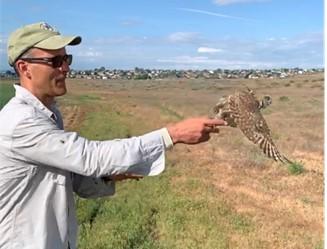

Ground-squirrel Survey Completed: Wildlife Biologist Fidorra and biologists across the Columbia Basin revisited known colony sites for Townsend’s and Washington ground-squirrels this spring. While a few colonies remain, many historic colonies were vacant. Local landowners supported the theory that a recent decline coincided with the harsh late snows of 2017-2018 around Tri-Cities, but long term declines had started long before.
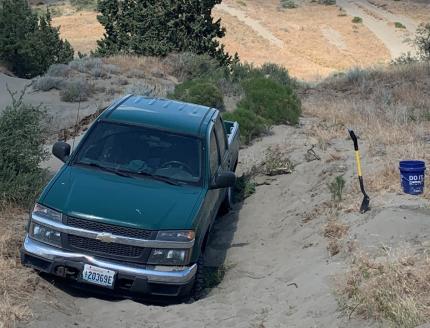
Providing Recreation Opportunities
Unapproved User-Built Bike Jump Removal: Natural Resource Specialist Frame disassembled and removed a total of five unapproved user-built bike jumps on Cheeky-Bugger and Wildcat trails. Some jumps were large and were constructed of fallen logs and rocks. After removal, Frame re-graded the trails back to their original state.


Another Successful Year of the Landowner Hunting Program: Private Lands Biologist Hulett worked with landowners enrolled in the Silver Dollar and Blackrock Landowner Hunting Program to complete and submit their 2023 Landowner Hunting Program report. In total, 21 bull elk and three cow elk were harvested across the six enrolled properties. Along with these landowner tags, 21 state drawn hunters were brought out to the properties for opportunities to harvest elk.
Providing Conflict Prevention and Education
Rattlesnake Hills Elk: Wildlife Conflict Specialist Hand processed and issued additional damage prevention permits to a landowner in elk area 3721. A trail camera was installed on a traditional route elk use to enter wheat fields near the Hanford National Monument. It will monitor elk use and activity.

Elk Thermal Imaging: Night-time hazing continues and the use of newly purchased thermal imaging optics have improved the ability to locate animals in crop areas in complete darkness.
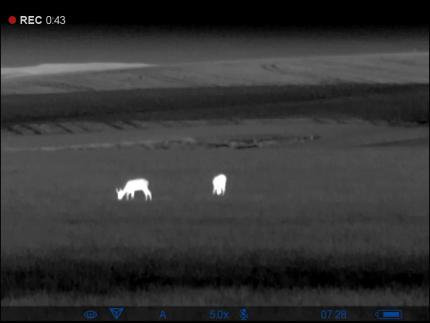
Pasco Rattlesnake Response: Wildlife Conflict Specialist Hand responded to a call in Spillman concerning an aggressive rattlesnake near the Columbia River. Three young teenage individuals abandoned their belongings near where the snake was initially observed. After a search of the area, no snake was located. Their belongings were returned, and education was provided on rattlesnake behavior and avoidance.
Two River’s Park Osprey: Wildlife Conflict Specialist Hand responded to a call concerning an osprey that was observed tangled with fishing line and attached to a tree from the previous day. One osprey was located at the area that was described but it was uninjured and flew away.
Prosser Beaver: Wildlife Conflict Specialist Hand received and responded to a complaint from an orchardist in the Prosser area concerning a beaver that had damaged a few cherry trees. Several preventive techniques were discussed including protective armament around the trees and possible trapping.
Horse Heaven Hill Pronghorn: Wildlife Conflict Specialist Hand and Enforcement Officer Kunz-Pfeiffer responded to a report from local power company staff members that a buck pronghorn antelope had an arrow in it. After contacting the landowner and obtaining permission to access the property, we conducted a search. No signs of the animal were located. We asked the landowner and neighboring landowners to contact us if they see any sign of the animal or scavenging bird activity.
Kahlotus Deer Damage: Wildlife Conflict Specialist Hand completed renewals of two Damage Prevention Cooperative Agreements for landowners in the Kahlotus area to address deer damage in winter wheat crops.
Kittitas County Conflict: Conflict Specialist Wetzel worked with several hay growers who were having problems with elk in crops. Elk have been hazed from irrigated hay, row crops, and at haystacks. Greenup is helping keep elk higher and on public land.
Yakima County Conflict: Conflict Specialist Wetzel worked with several hay growers who were having problems with elk in crops. Elk have been hazed from irrigated hay, row crops, and orchard areas.
Wetzel Cougar: Conflict Specialist Wetzel assisted enforcement with trapping a cougar that killed a chicken and was loitering in a neighborhood. Trapping is ongoing.
I-90 Wolf Vehicle Collision: A dead wolf was recovered after being struck on I-90. The wolf had a tracking collar.
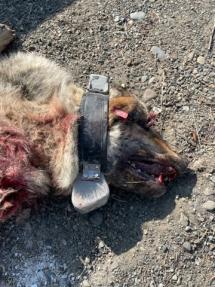
Naches Elk Relocation: An elk was relocated away from a goat pen where it had been living for several months. The elk was an orphan that attached to the goats and had become a nuisance to the livestock owner. Biologists Mackey and Moore relocated the elk to the Little Naches River area.
Conserving Natural Landscapes
L. T. Murray Wildlife Area Weed Control: Natural Resource Technician Blore flew with Central Valley Helicopters to identify heavy weed populations in the 2022 Vantage Highway Fire burn area. Assistant Manager Winegeart hired the helicopter to spray 50 acres of areas identified for whitetop and Russian knapweed. The fire removed most canopy cover from the riparian areas making weed identification and herbicide application easier.

L. T. Murray Riparian Health: Manager Morrison and Assistant Manager Winegeart accompanied some Habitat Program staff to the Whiskey Dick Unit for drone flights which focused on creek banks and possible areas in need habitat enhancement.

Wenas Wildlife Area Weed Spraying: Biologist Miller, Natural Resource Technician Frame, and Natural Resource Specialist Stoltenow all have been thoroughly covering the wildlife area in search of Scotch thistle, Canada thistle, and whitetop to be sprayed with herbicide. These species are all noxious and invasive weeds that can harm native plants and animals. Much of the spraying is done with backpack sprayers.
Miracle Mile Acquisition or Conservation Easement: Wenas Wildlife Area Manager Hughes, Habitat Biologist Meyer, and Environmental Planner Teske met with a landowner bordering the Wenas Wildlife Area. The landowner is interested in conserving their property either by selling it to WDFW or by putting it into a conservation easement. The three toured the property and took photos displaying the varying forms of habitat that remain on the property. The property includes shrubsteppe habitat leading into areas with ponderosa pine. It also includes a riparian section of North Wenas Creek. Hughes, Meyer and Teske are planning to apply for a grant a couple years from now to help conserve the property. Getting photos and documenting information now is an important step in this process.

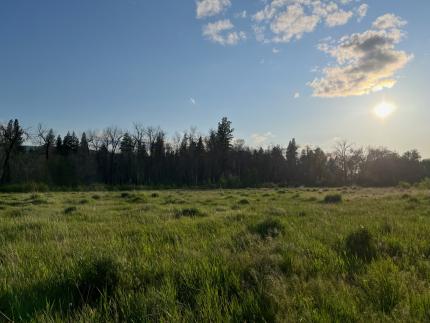
Habitat Projects on Private Lands: Private Lands Biologist Hulett along with Private Lands Technician Manderbach completed all of their spring shrub plantings. In total, 250 additional shrubs were planted on two sites in Yakima County. This brings the total number of shrubs planted in 2023 to 900 across nine sites.

Colockum Wildlife Area Forestry: Work continues on the forest treatment and thinning work on the Colockum Wildlife Area. Contract loggers are working in Unit 5 and Unit 6, while also hauling logs from log decks in Unit 1. Work will continue all summer unless it is restricted by fire danger restrictions.


Oak Creek Wildlife Area Weed Spraying: Biologist Charlet, Natural Resource Technician Boggs, and Natural Resource Worker Close have been diligently applying herbicide to Scotch thistle, Canada thistle, knapweed, yellow star thistle across the Oak Creek and Cowiche units. This is all spot treatment via backpack sprayers and all-terrain vehicles.


Providing Education and Outreach
L. T. Murray Wildlife Area Kiosk: Assistant Manager Winegeart and Natural Resource Workers Hamlin and Schneider, set five posts in preparation for a volunteer project that will rebuild the large three panel kiosk that burned in the 2022 Vantage Highway fire.

Oak Creek Wildlife Area Volunteer Work Party with the Rocky Mountain Elk Foundation: On May 19 and 20, volunteers with the Rocky Mountain Elk Foundation (RMEF) assisted Oak Creek staff members in the clean-up of a recent 100-acre acquisition along the Tieton River. This was the site of a homesite and small farm. Although, WDFW Capital and Asset Management Program (CAMP) crews removed the larger structures, several small outbuildings remained as well as a small orchard. Volunteers removed and piled the fruit trees, removed three outbuildings, and removed approximately 500 feet of fencing. In total approximately 15 cubic yards of construction debris was hauled to the landfill.


Oak Creek Wildlife Area Signs, Kiosk, and Cattle Guards: Oak Creek staff members began cleaning cattle guards on the Cowiche Unit, along with installing a green dot management sign and kiosk within a recent acquisition to the unit.
Conducting Business Operations and Policy
Unfortunate Change to Providing Technical Assistance to Landowners: Private Lands Biologist Hulett organized all State Acres for Wildlife Enhancement (SAFE) contracts in Region 3 to hand over to the local county Natural Resource Conservation Service (NRCS). As of April 7, 2023, WDFW is no longer the Technical Service Provider (TSP) for any of the SAFE contracts in Washington State. Instead NRCS will be taking responsibility of all SAFE contracts. Hulett passed off all Franklin County SAFE contracts to NRCS on May 25, 2023. They are waiting to pass off Benton County’s SAFE contract documents until they can meet with a representative for Benton County NRCS, but there is currently not an NRCS staff member for Benton County.
Other
L. T. Murray Fence: Assistant Manager Winegeart and Natural Resource Specialist Nass repaired riparian exclosure fence on the Parke Creek subunit of the Quilomene Unit.
Giffon Lake Outflow: In order to maintain water levels and flow in Giffon Lake and surrounding wetlands, Manager Kaelber and Natural Resource Technician Manderbach removed beaver debris and sediment from the Giffon Lake outflow at the Sunnyside Headquarters Unit. The operation required launching a small boat to access the outflow and successfully dislodge the debris.

Sunnyside Headquarters Food Plot: Manager Kaelber, Assistant Manager Jahns, and Natural Resource Technician Manderbach seeded several food plots along circle edges at the Sunnyside Headquarters Unit. The crops planted will provide valuable forage for wildlife throughout the entirety of the growing season.


Sunnyside and Snake River Nesting Season: Sunnyside and Snake River staff members have observed a variety of hatchlings and fledglings throughout the wildlife area this spring including great horned owls, barn owls, and several species of waterfowl and shorebirds.
